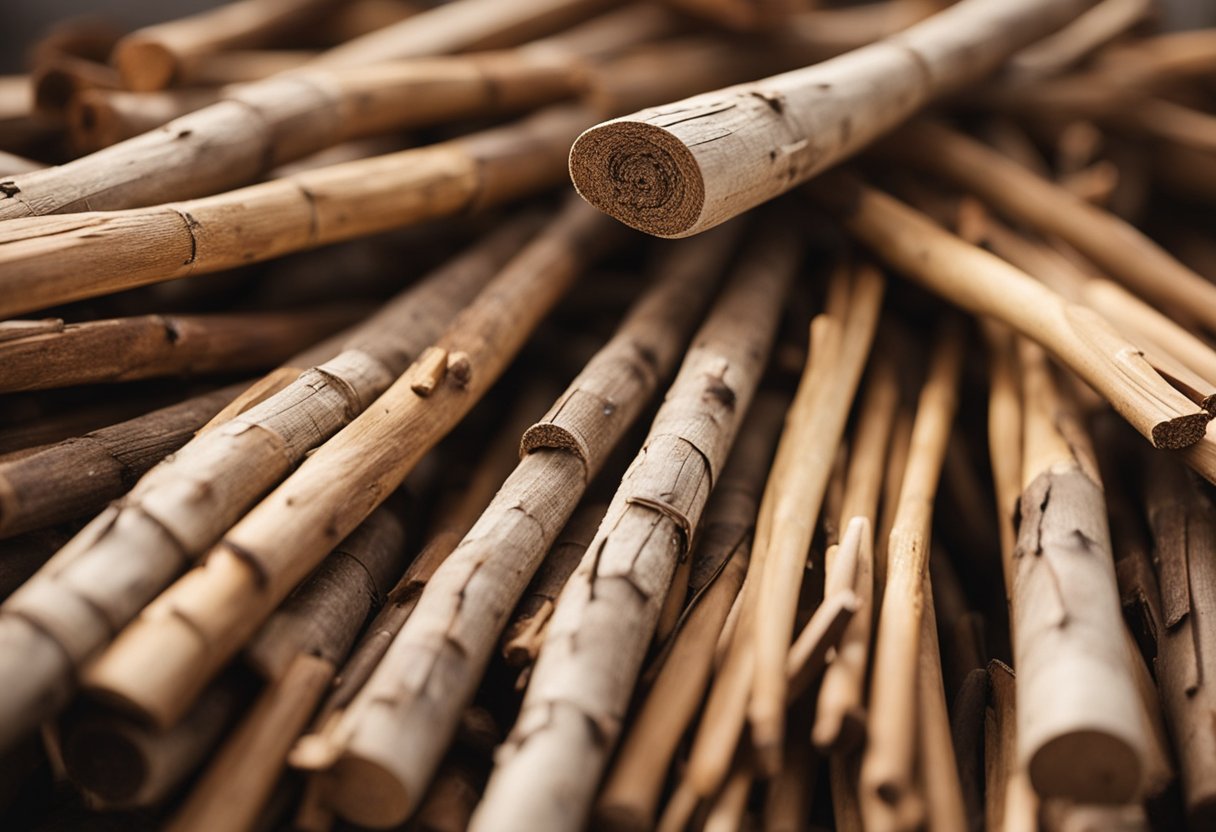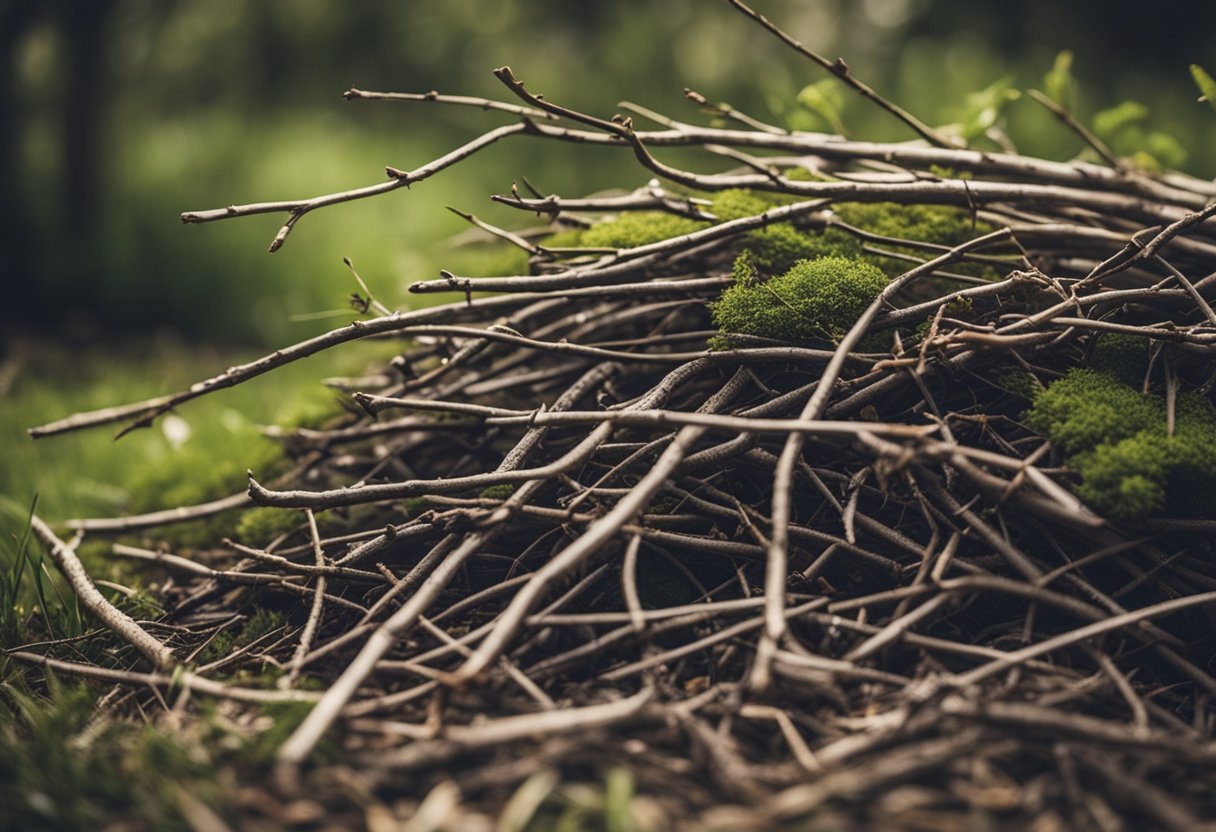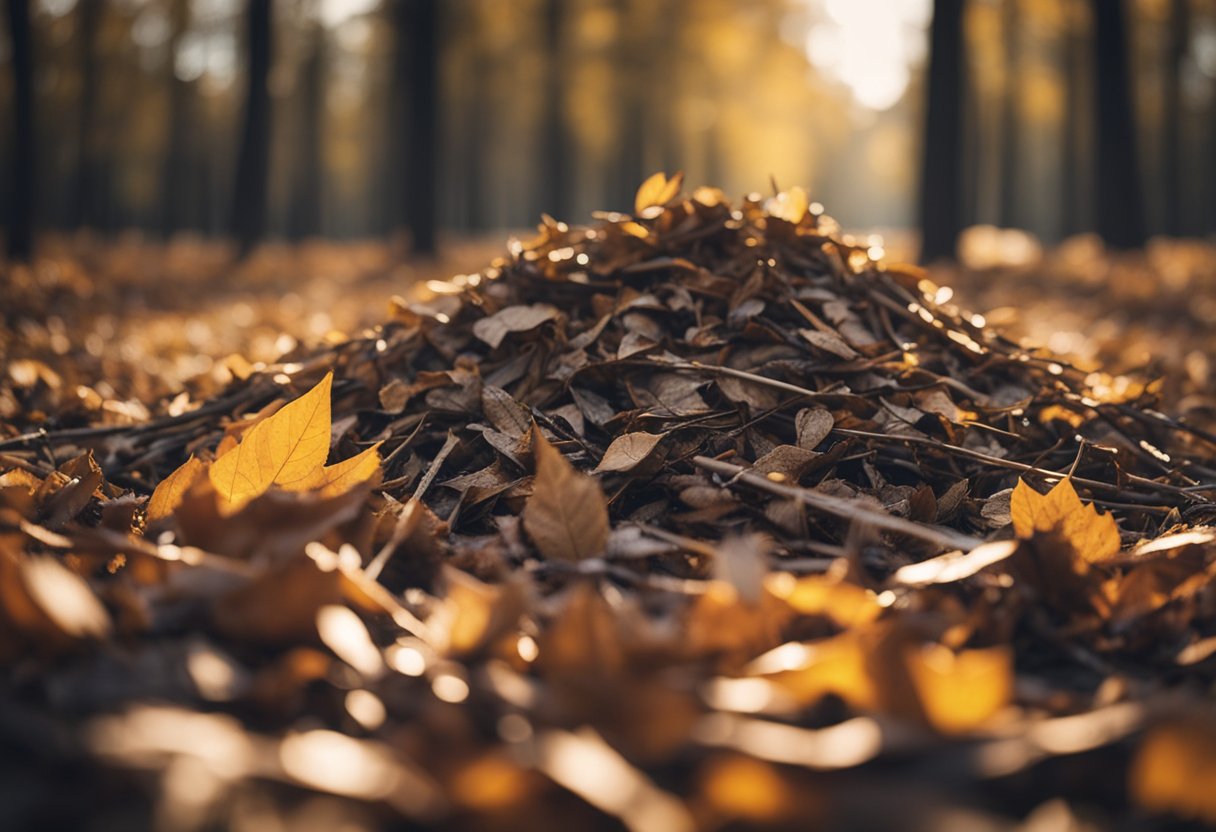As an Amazon Associate I earn from qualifying purchases.
At A Glance
Yes, you can compost sticks. Sticks, being organic material, will break down over time in a compost pile. However, they are considered “brown” material and are high in carbon, so it’s beneficial to balance them with “green” materials like food scraps or lawn clippings to maintain a healthy carbon to nitrogen ratio in your compost pile. It’s advisable to break or chop the sticks into smaller pieces to expedite the decomposition process, as larger sticks can take a long time to break down.
Composting is a great way to reduce waste and create nutrient-rich soil for your garden. But what about sticks? Can you compost them? The answer is yes! Composting sticks not only reduces waste but also provides numerous benefits for your garden.

Sticks are a great addition to your compost pile as they add structure and help with aeration. However, it’s important to prepare them properly before adding them to your compost pile. Cut them into smaller pieces to speed up the decomposition process and make sure they are not too thick or woody. In a hot composting unit, sticks can take 4-6 weeks to compost, while in a cold composting unit, it can take up to several years depending on the size of the pieces, aeration, moisture, and fungal growth inside the pile.
When sticks have fully composted, they create a nutrient-rich soil that can be used to improve the health of your garden. Composting sticks is a great way to reduce waste, improve the health of your garden, and create a more sustainable lifestyle. So, next time you’re cleaning up your yard, don’t throw away those sticks, add them to your compost pile!
Why Compost Sticks?

As someone who is interested in composting, you may be wondering if you can compost sticks. The answer is yes, and there are several reasons why you should.
Firstly, composting sticks is an excellent way to reduce waste. Sticks are often considered trash and are thrown away in landfills where they take up valuable space. By composting sticks, you can divert them from the landfill and turn them into a valuable resource for your garden.
Secondly, sticks are a great source of organic matter. Organic matter is essential for healthy soil, and composting sticks can help to improve the quality of your soil. When sticks are composted, they break down into humus, which is a dark, nutrient-rich material that is great for plants.
Thirdly, sticks are a natural material that will decompose over time. When sticks are thrown away in the trash, they can take years to break down in a landfill. By composting sticks, you can speed up the decomposition process and turn them into a useful resource in a matter of weeks or months.
Overall, composting sticks is a great way to reduce waste, improve soil quality, and speed up the decomposition process of natural materials. It’s a simple and effective way to make a positive impact on the environment and your garden.
Materials for Composting
When it comes to composting, it’s important to know what materials are compostable and what materials are not. Composting is the process of breaking down organic matter into nutrient-rich soil. Composting is a great way to reduce waste and create a healthy soil environment for your plants.
Compostable Materials
There are a lot of materials that can be composted. These include:
- Sticks and twigs: These can be added to your compost pile as long as they are not too thick. It’s best to break them down into smaller pieces before adding them to the pile.
- Leaves and grass clippings: These are great sources of nitrogen and can be added to your compost pile in large amounts.
- Coffee grounds: These are rich in nitrogen and can be added to your compost pile in moderation.
- Fruit and vegetable scraps: These are great sources of nitrogen and can be added to your compost pile in large amounts.
- Eggshells: These are rich in calcium and can be added to your compost pile in moderation.
- Paper, cardboard, and newspaper: These can be added to your compost pile as long as they are not coated in plastic or other non-compostable materials.
- Bread, filters, and dryer lint: These can be added to your compost pile in moderation.
- Straw, cheese, seeds, peels, rice, weeds, napkins, nut shells, herbs, flowers, food scraps, tea bags, tea leaves, pencil shavings, houseplants, dead houseplants, potpourri, ashes, feathers, bones, hay, corn cobs, seaweed, manure, tissues, toilet paper, and towels: These can all be added to your compost pile in moderation.
Non-Compostable Materials
There are also materials that should not be added to your compost pile. These include:
- Meat and dairy products: These can attract pests and create odors.
- Fats and oils: These can also attract pests and create odors.
- Diseased plants: These can spread disease to your compost pile and your garden.
- Pet waste: This can contain harmful bacteria and parasites.
- Charcoal ash: This can contain chemicals that are harmful to plants.
- Glossy paper and magazines: These are coated in non-compostable materials.
- Plastic and metal: These materials do not break down and can harm the environment.
In summary, composting is a great way to reduce waste and create a healthy soil environment for your plants. It’s important to know what materials are compostable and what materials are not. Stick to compostable materials like sticks, twigs, leaves, grass clippings, coffee grounds, fruit and vegetable scraps, eggshells, paper, cardboard, newspaper, bread, filters, dryer lint, straw, cheese, seeds, peels, rice, weeds, napkins, nut shells, herbs, flowers, food scraps, tea bags, tea leaves, pencil shavings, houseplants, dead houseplants, potpourri, ashes, feathers, bones, hay, corn cobs, seaweed, manure, tissues, toilet paper, and towels. Avoid non-compostable materials like meat and dairy products, fats and oils, diseased plants, pet waste, charcoal ash, glossy paper and magazines, plastic, and metal.
Understanding the Composting Process

Composting is a natural process that involves the decomposition of organic matter into nutrient-rich soil. Understanding the composting process is essential for creating high-quality compost. In this section, I will explain the different stages of composting and the role of microorganisms, air, water, and temperature in the decomposition process.
The Role of Microorganisms
Microorganisms, including bacteria, fungi, and protozoa, play a critical role in the composting process. These microorganisms break down organic matter into simpler compounds, such as carbon dioxide, water, and humus. They also help to regulate the temperature and moisture content of the compost pile.
The Importance of Aeration and Moisture
Aeration and moisture are essential for the composting process. Aeration provides oxygen to the microorganisms, which helps them to break down the organic matter more efficiently. Moisture is required to keep the compost pile moist, which is necessary for the growth and activity of the microorganisms.
The Decomposition Process
The decomposition process involves the breakdown of complex organic compounds into simpler compounds. This process is facilitated by the microorganisms that live in the compost pile. As the microorganisms break down the organic matter, they release heat, which raises the temperature of the compost pile. The high temperature helps to kill weed seeds and pathogens that may be present in the compost pile.
In summary, composting is a natural process that involves the decomposition of organic matter into nutrient-rich soil. The process is facilitated by microorganisms, which break down the organic matter into simpler compounds. Aeration and moisture are essential for the composting process, as they provide oxygen and water to the microorganisms. The decomposition process is facilitated by the microorganisms that live in the compost pile, and the high temperature helps to kill weed seeds and pathogens.
Building Your Compost Pile
If you’re looking to start composting, building a compost pile is an easy and effective way to turn organic waste into nutrient-rich soil. Here are some tips to help you get started.
Choosing a Compost Bin
While you can simply create a compost pile directly on the ground, using a compost bin can help contain the materials and speed up the composting process. There are many types of compost bins available, from simple DIY options to more complex commercial models. Choose a bin that works for your space and needs.
Layering Your Compost
To create a healthy compost pile, you’ll want to layer your organic waste with a mix of carbon-rich “browns” and nitrogen-rich “greens.” The ideal ratio is 2:1 browns to greens. Browns include things like dried leaves, sawdust, and paper, while greens include things like fruit and vegetable scraps, grass clippings, and coffee grounds.
Start with a layer of browns at the bottom of your bin or pile, then add a layer of greens. Continue layering until you reach the top of your bin or pile.
Maintaining Your Compost
To help your compost pile break down quickly and efficiently, it’s important to maintain the right conditions. This includes keeping your pile moist but not too wet, turning it regularly to add oxygen, and monitoring the temperature.
You should also avoid adding certain materials to your compost pile, such as meat, dairy, and oily foods, which can attract pests and slow down the composting process.
With time and patience, your compost pile will turn into nutrient-rich soil that you can use in your garden or for potted plants. Just remember to give it enough time to fully break down before using the finished compost.
Composting Challenges and Solutions
Composting is a popular practice that can help reduce waste and create nutrient-rich soil for your garden. However, it’s not always smooth sailing. Here are some common challenges you may encounter while composting, and how to address them.
Common Pests
Pests like fruit flies, ants, and rodents can be attracted to your compost pile, especially if you’re composting food scraps. To prevent pests from taking over your compost, make sure to bury food scraps deep within the pile. You can also cover the pile with a layer of leaves or straw to discourage pests from getting too close.
If you’re still having trouble with pests, try adding a layer of diatomaceous earth to the top of the pile. This natural substance is made from the fossilized remains of tiny marine creatures and can help repel pests without harming your compost.
Addressing Pathogens
Composting can be a great way to reduce the amount of pathogens in your waste, but it’s important to take some precautions to prevent the spread of harmful bacteria. Make sure to avoid composting any meat, dairy, or pet waste, as these materials can contain harmful pathogens.
You should also make sure to maintain a good balance of carbon and nitrogen in your compost pile. Too much nitrogen can create an environment where harmful bacteria can thrive, so make sure to add plenty of carbon-rich materials like leaves and straw.
Managing Odor
One of the biggest complaints about composting is the smell. If your compost pile is producing an unpleasant odor, it’s likely due to too much moisture. Make sure to turn your compost regularly to aerate it and prevent it from getting too wet.
You can also add some dry materials like leaves or sawdust to absorb excess moisture and reduce odor. If all else fails, you can try adding a compost accelerator to speed up the decomposition process and reduce odor.
Remember, composting is a natural process, and it’s normal to encounter some bumps along the way. By following these tips, you can help ensure that your compost pile stays healthy and productive.
Using Composted Sticks in Your Garden
I have found that composted sticks make for an excellent fertilizer for my garden. They are an excellent source of carbon, which is essential in the composting process. The carbon in the sticks helps to balance out the nitrogen-rich green materials, such as grass clippings and kitchen scraps, that are added to the compost pile.
When you compost sticks, you are creating a nutrient-rich soil amendment that can help to improve the health and vitality of your plants. The composted sticks can be added directly to garden beds as a soil amendment or used as a top dressing around plants.
One of the benefits of using composted sticks in your garden is that they can help to improve the soil structure. As the composted sticks break down, they create channels in the soil that allow air and water to penetrate more easily. This can help to improve soil drainage and reduce the risk of soil compaction.
Another benefit of using composted sticks is that they can be used as a bedding material for worms. Worms are an essential part of the composting process, and using composted sticks as a bedding material can help to create a healthy environment for them to thrive in.
Overall, I have found composted sticks to be an excellent addition to my garden. They are easy to prepare and can help to improve the health and vitality of my plants. If you have a lot of sticks in your yard, I would highly recommend composting them to create a nutrient-rich soil amendment for your garden.
